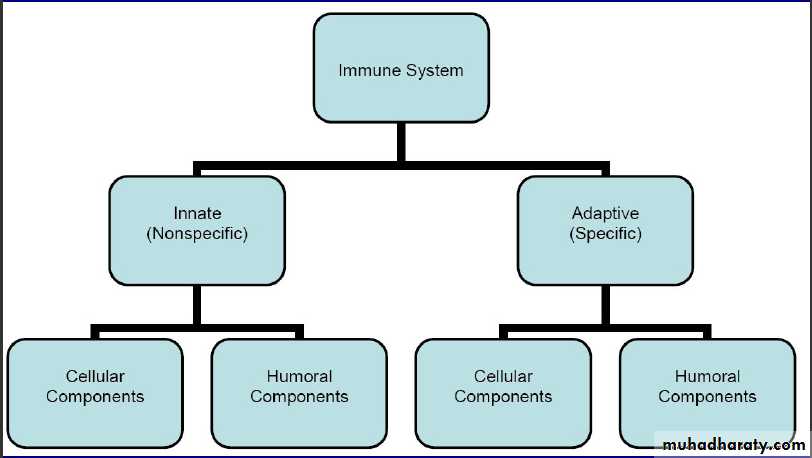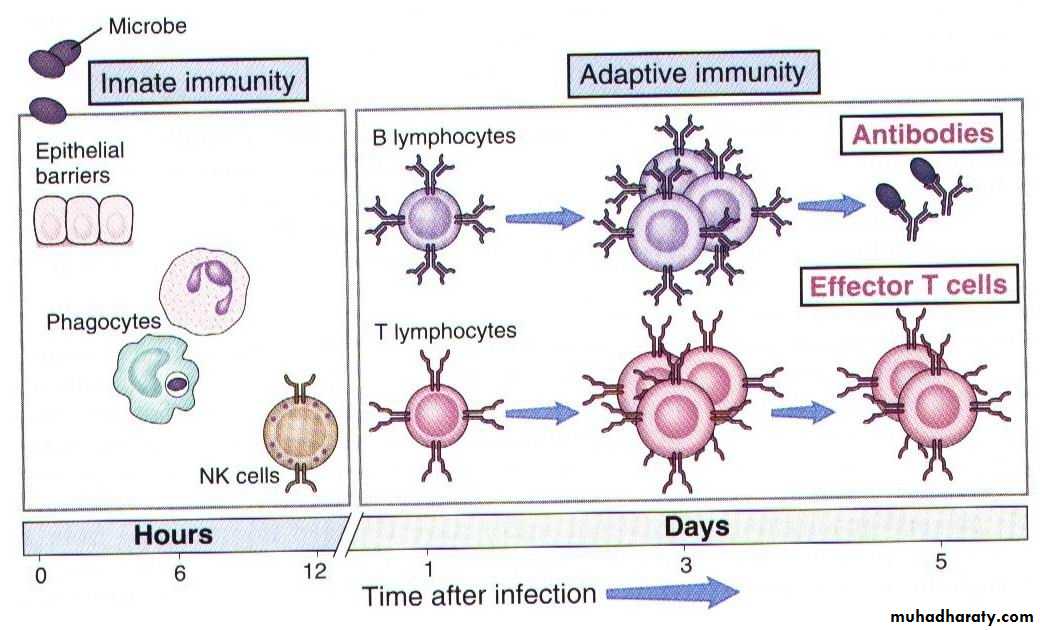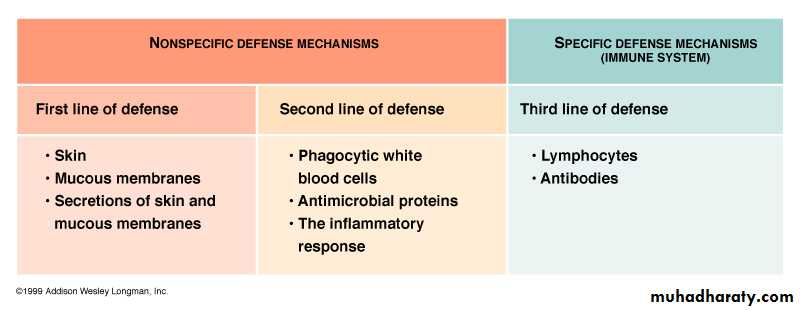Immunology –Nonspecific Host DefensesLec,no.1Dr, Huda Ibrahim.
TEACHING OBJECTIVES (2 hours):1- To recognize the significance of the immune system in combating infection and disease.
2. To distinguish between the innate (non-specific) and adaptive (specific) immune systems.3. To understand the mechanisms of combating infection/disease (killing pathogens).
4. To know the main components of innate immunity.5. To recognize cells participating in innate immunity
6. To comprehend the mechanism of action of the innate immunity•Immunology is the study of our protection from foreign macromolecules or invading organisms and our responses to them.•Host – e.g. me!!!!•Foreign macromolecule, antigen – e.g. virus protein, worm, parasite (Everything that should not be in my body)
Immune system = cells, tissues, and molecules that mediate resistance to infections
Immunity = resistance of a host to pathogens and their toxic effects•Immune response = collective and coordinated response to the introduction of foreign substances in an individual mediated by the cells and molecules of the immune system
Role of the immune system
Defense against microbes
Defense against the growth of tumor cells
Homeostasis
–destruction of abnormal or dead cells (e.g. dead red or white blood cells, antigen-antibody complex)
Jenner - Smallpox vaccine
Noticed that milk made who had contracted cowpox did NOT get smallpoxTest on an 8 year old boy, injected him with cowpox sera, he did not get smallpox after exposure.
Vaccine was invented (latin vacca means ”cow”)
1880’s- Metchnikoff discovered phagocytic cells that ingest microbes and particles
1890- von Behring and Kitasato discovered blood sera could transfer immunityTypes of immunity
1.Innate (non-adaptive)–first & 2nd line of immune response
–relies on mechanisms that exist before infection
2.Acquired (adaptive)
–3rd line of response (if innate fails)
–relies on mechanisms that adapt after infection
–handled by T- and B- lymphocytes
Cells of the Immune System
Basophils
NeutrophilsEosinophils
Granulocytic
Langerhans &Macrophages
Kupffer cells
Dendritic cells?
Monocytic
CytotoxicHelper
Suppressor
T-cells
Plasma
cells
B-cells
Dendriticcells?
lymphoid cells
Myeloid cellsEach of major subdivision has both cellular and humoral components
Distinction Between Innate and Adaptive Immune Responses
Innate immunityImmediate (0-4 hours)
Non –antigen specific
Not posses immunological memory
Adaptive immunity provides a more universal line of defense
long-lived memory to provide protection upon re-infection
Generation of Ag-specific effector cells
Early (4-96 hours)
Late (>96 hours)
Innate Immunity
Adaptive ImmunityCharacteristics of Innate and Adaptive Immunity
• No Immunologic• memory
• Antigen independent
• No time lag
• Not antigen specific
• Antigen dependent
• A lag period
• Antigen specific
• Development
• of memory
Disease occurs only when :
*the bolus of infection is high
*the virulence of the invading organism is great
*or when the immunity is compromised.
The main function of the immune system is self/ non-self discrimination which is necessary to
*protect the organism from invading pathogens.
*eliminate modified or altered cells(e.g., malignant cells).
Detrimental effects of the immune system
*Hypersensitivity reaction.*Autoimmune disease (immune response directed toward self tissues).
Different types of Immunity
1- Species2- Racial
3- Individual
Species and Immunity
•Immunity refers to total resistance to a Pathogen by all members of the speciese.g., Human do not get plant diseases
• Humans do not get some animal diseases
•Dependent on Human configuration physiology ? Biochemical difference
Race - Immunity
•Genetic resistance Plasmodium falciparum malaria resistance in Africa
•In sickle cell anemia immune to malaria
Individual - Immunity
•Twins homozygous twins exhibit similar resistance
Three Lines of Defense Against Infection
Protection Against Invading Pathogens
1. First Line of Defense: Non-specific natural barriers which restrict entry of pathogen.Examples: Skin and mucous membranes.
2. Second Line of Defense: Innate non-specific immune defenses provide rapid local response to pathogen after it has entered host.
Examples: Fever, phagocytes (macrophages and neutrophils), inflammation, and interferon.
3. Third line of defense: Antigen-specific immune responses, specifically target and attack invaders that get past first two lines of defense.
Examples: Antibodies and lymphocytes.
Components of innate immune system
Innate host defenses:A- Anatomical barriers.
B- Humeral factors.
C- Cellular components.
Anatomical barriers
First Line of Defense:
I. Mechanical Defenses1. Skin : Epidermis Contains Langerhans cells, dead cells, and keratin (waterproof).
Infections are rare in intact skin. Exceptions:
• Hookworms can penetrate intact skin
• Dermatophytes: “Skin loving” fungi
Mechanical defences……..
2. Mucous Membranes: Line gastrointestinal, genitourinary, and respiratory tracts.Two layers: Ouer epithelial and inner connective layer.• Epithelial layer secretes mucus which maintains moist surfaces.
• Although they inhibit microbial entry, they offer less protection than skin.
• Several microorganisms are capable of penetrating mucous membranes:
• Papillomavirus, Treponema pallidum, Enteroinvasive E. coli ,Entamoeba histolytica
Mechanical defences…
• 3. Lacrimal apparatus: washing and blinking prevents microbes from settling on the eye surface.• 4. Saliva: Washes microbes from teeth and mouth mucous membranes.
• 5. Mucus: Thick secretion that traps many microbes.
• Nose hair: Coated with mucus filter dust, pollen, and microbes.
• 6. Ciliary Escalator: Cilia on mucous membranes of lower respiratory tract move upwards towards throat
Mechanical defences….
• 7. Coughing and sneezing: Expel foreign objects.
• 8. Epiglottis: Covers larynx during swallowing.
• 9. Urination: Cleanses urethra.
• 10. Vaginal Secretions: Remove microbes from genital tract.
Sebum: Oily substance produced by sebaceous glands that forms a protective layer over skin. Contains unsaturated fatty acids which inhibit growth of certain pathogenic bacteria and fungi.
• pH: Low, skin pH usually between 3 and 5. Caused by lactic acid and fatty acids.
• Perspiration: Produced by sweat glands. Contains lysozyme and acids.
• Lysozyme: Enzyme that breaks down gram-positive cell walls. Found in nasal secretions, saliva, and tears.
Chemical defences…..
• Gastric Juice: Mixture of hydrochloric acid, enzymes, and mucus. pH between 1.2 to 3 kills many microbes and destroys most toxins. Many enteric bacteria are protected by food particles.• Helicobacter pylori neutralizes stomach acid and can grow in the stomach, causing gastritis and ulcers.
• Transferrins: Iron-binding proteins in blood which inhibit bacterial growth by reducing available iron.
Normal flora , secret toxic substance or by competing with pathogenic bacteria.
B-Humeral factors (2nd line )
*occurs after infectious agents have penetrated tissue*play an important role in inflammation. It includes:
1-Complement system :(it’s activation lead to opsonization & lysis of bacteria).
2-Coagulation system: increase vascular permeability & act as chemotactic)
*e.g .B-lysin produced by platelets
3-Interferon’s
•Interferon's (IFNs) are natural proteins produced by the cells of the immune system of most vertebrates in response to challenges by foreign agents such as viruses, parasites and tumor cells. Interferon's belong to the large class of glycoproteins known as cytokines•Interferon's are more useful than Antibodies
4- Interleukin-1
*induce fever (pyrogenic)*production of acute phase protein (CRP , fibrinogen, ceruloplasmin ), which are synthesized in the liver in response to IL-1, IL-6 & TNF which are produced by macrophage.
C – Cellular barriers to infection
1- Natural killers(NK) & Lymphokine activated killer (LAK)cells2-Neutrophils
3-Macrophage4-Eosinophils
Site Component Functions
Effector mechanisms in Innate Immunity -1Peristalsis, low pH
bile salts, fatty acids
columnar cells
GI tract
Skin
squamous cells
sweat
desquamation
flushing, fatty acids
tracheal cilia
Lung
mucociliary elevator
surfactants
Site Component Functions
Effector mechanisms in Innate Immunity -2Nasopharynx
and eye
mucus, saliva, tears
flushing, lysozyme
Phagocytes
Blood and
Lymphiod
organs
phagocytosis and intracellular killing
K, NK & LAK cells
direct and antibody dependent cytolysis
Site Component Functions
Effector mechanisms in Innate Immunity -3Serum and other serous fluids
lactoferrin, transferrin
iron deprivation
interferons, TNF-
antiviral proteins phagocyte activation
lysozyme
peptidoglycan hydrolysis
Fibronectin & complement
opsonization, enhanced phagocytosis, inflammation



